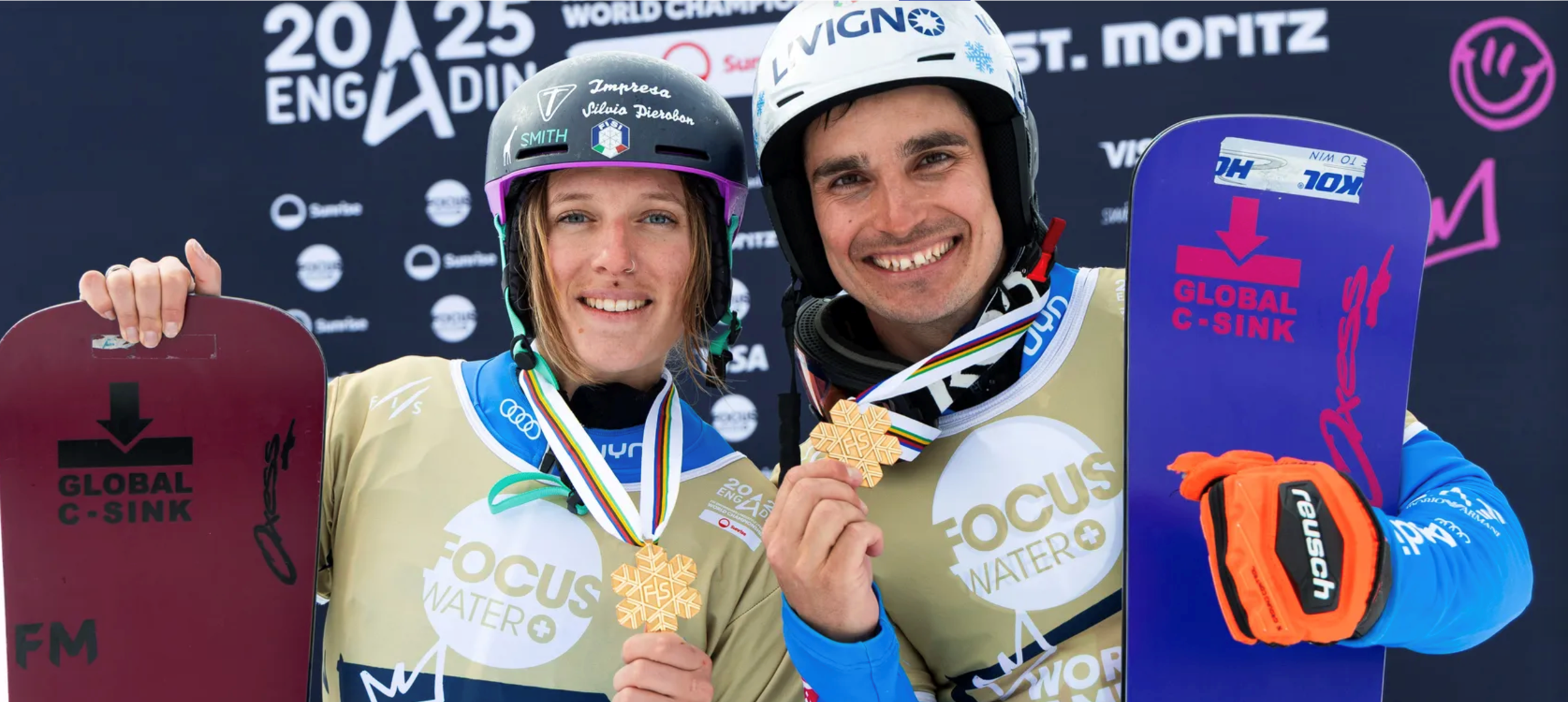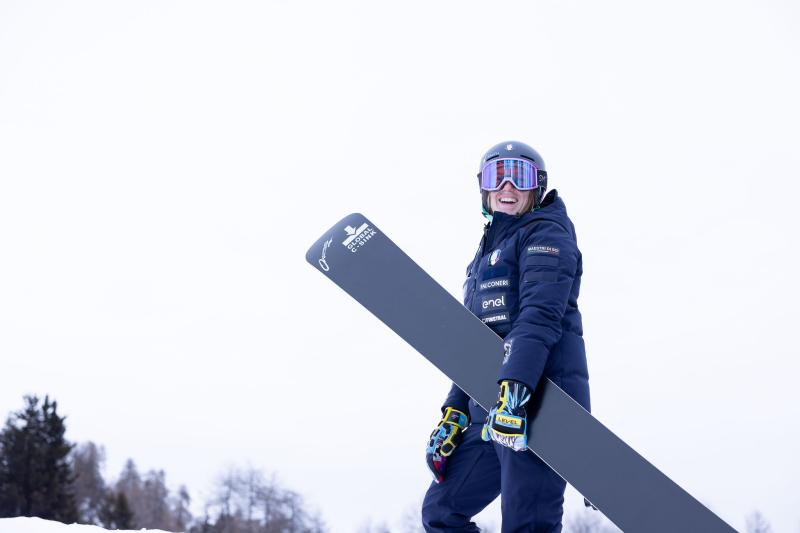
Biochar meets powder snow
How biochar and snowboarding work together for nature

They secure the World Champion title in St. Moritz (Switzerland): Elisa Caffont and Maurizio Bormolini win the team parallel.
One of the biggest problems of our time is climate change. By burning coal, oil or natural gas, we are releasing CO2 that has been stored for centuries. And for good reason: CO₂ is a greenhouse gas, trapping heat in the earth's atmosphere and preventing it from escaping into the air.
We are currently experiencing what happens if this heat is not stored or the CO2 is not released: the climate is warming year after year as a result of the excessive release caused by the burning of resources. We are confronted with extreme weather events, melting glaciers, rising sea levels and changing ecosystems.
There are numerous solutions to this problem: These include the use of renewable energies, efficient energy use and, of course, adapting consumer behavior - from transportation and food production to the fashion industry.Storing carbon with biochar
Another option, however, is to store the released carbon again and extract it from the atmosphere. And this can be done with biochar.
The biochar then used on large agricultural fields, for example, by lifting it underground. The concept is called "carbon farming" and enables carbon to be actively absorbed from the air.
The process is promising and countries are considering financially rewarding farmers who use this method. So far, however, this has not been the rule and in the meantime the sale of CO2 certificates, for example, is helping to cover the costs.
A snow-covered stage for biochar
With C-Sink-Sports, which is based on the collaboration between the snowboard manufacturer Oxess and Carbon Standards, we are offering this process and its numerous possibilities a tangible stage that is closer to the everyday lives of the population, thereby enabling the broader population to understand how to deal with CO2 in the future. It is clear that snowboarding is also a niche sport. But our credo is: instead of letting it go for this reason, we prefer to start here in the snow and then continue our journey.
And so biochar is now finding its way not only onto the fields, but also onto the boards and onto the slopes, where it is also extracting CO2 from the atmosphere from nature, with nature and in nature.
It not only reduces carbon on every descent, but also numerous other benefits. The biochar makes the board more stable by efficiently absorbing vibrations, its durability also increases the lifespan of the board, and it can compensate for temperature fluctuations so that the board remains supple in cold conditions and does not become too soft in warmer temperatures.
The voices from the mountains
And the successes speak for themselves: top places in the races and satisfied voices from those who whizz down the slopes on their boards, turn after turn.
While athlete Daniele Bagozza, for example, struggles with mundane challenges such as lack of sleep due to excitement, worrying about a board that doesn't do what he wants is a thing of the past.
Maurizio Bormolini, who won the overall Alpine Snowboard World Cup in the 2024/25 World Cup season on C-Sink snowboards, emphasizes: "The development of technologies - especially in the last two years - helps enormously. The implementation of new materials makes the board more stable, which helps him to stand more securely on the board and therefore take more risks. And the latter is hugely important as can be seen every time it's a matter of milliseconds just before the end of the piste and thus victory!"
So, it's no surprise that professional boarder Elisa Caffont tells us that equipment plays a special role as the performance level of her competitors increases. Her most important criterion? Safety in different conditions on the slopes. Because with climate change, the conditions on the slopes also change regularly and so boarders have to be able to deal with soft snow as well as icy slopes. In addition to skills, this also requires the right equipment, which is raised to a new level with the technology from C-Sink-Sports. And so Elisa can now fight for victory among the women with the "best board".
Elisa, Maurizio and Daniele are therefore keen to reduce carbon emissions in the atmosphere and not only success with their boards but also make a contribution to improving the climate so that they can continue to enjoy snow sports.
The successes of the 2024 / 2025 season:
Maurizio Bormolini once again achieved numerous successes with his board last winter. He was:
- First in the Engadine (Switzerland), 2025, parallel team with Elisa Caffont
- Third in Santa Cristina Val Gardena (Italy), 2025, Men's Giant Slalom
- First in Rogla (Slovenia), 2025, parallel giant slalom
- First in Scuol (Switzerland), 2025, parallel giant slalom
- First in Mylin (China), 2025, Parallel, Slalom
- In the 2024/25 World Cup season, Maurizio Bormolini won the overall Alpine Snowboard World Cup on C-Sink snowboards.
The Italian Elisa Caffont was also successful on her C-Sink Oxess board. She was:
- First in the Engadine (Switzerland), 2025, parallel team with Maurizio Bormolini
- Third in Bad Gastein (Austria), 2025, parallel slalom
- Third in in Rogla (Slovenia), 2025, parallel giant slalom
- Third in Winterberg (Germany), 2025, Parallel Salom Team
And the Italian Daniele Bagozza also achieved numerous successes:
- First Santa Cristina Val Gardena (Italy), 2025, Men`s Giant Slalom
- First in Yanqing, 2025, parallel slalom
This is biochar
The most well-known CO2 reservoirs are quite simply provided by nature: trees. They absorb carbon dioxide from the air simply by existing. If you are now thinking: Yes, then we simply have to reforest and forests, you are thinking too short-sightedly. Because as emissions rise, there is an increasing need for storage, for which there is simply not enough land. This is why biochar makes it possible to use the power of trees outside of forests. Instead of the traditional burning of excess wood in wood processing, for example, the wood is heated at temperatures above 400 degrees in the absence of air using a process called pyrolysis. Put simply, this process produces energy and biochar. While the former can be used to produce electricity, the carbon in the biochar is stored for the long term.Climate-neutral production - riding smarter
The snowboards of the official C-Sink Sports racers have been climate-neutral since the beginning of the collaboration between Oxess, the producer of the snowboards, and Carbon Standards, as all greenhouse gas emissions generated during production are offset through the use of permanent carbon sinks in accordance with Carbon Standards. We are currently working on making the regularly sold boards that carry the C-Sink label climate-neutral and offsetting the emissions.Photo source: @Finja Basan




